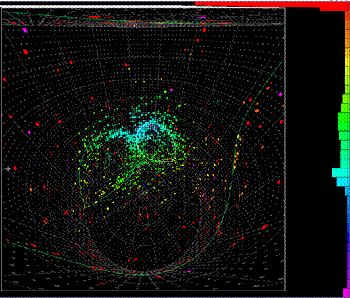The First T2K Neutrino Event Observed at Super-Kamiokande From KEK
 |
Physicists from the Japanese-led multinational T2K collaboration announced today that they had made the first detection of a neutrino which had travelled all the way under Japan from their neutrino beamline at the J-PARC facility in Tokai village to the Super- Kamiokande underground detector, 295 km (185 miles) away from Tokai.
They have constructed their new neutrino beamline, which will deliver the world's most powerful neutrino beams, to study the mysterious phenomenon known as neutrino oscillations, and the observation of this event proves that their study can now begin.
The T2K experiment has been built to make measurements of unprecedented precision of known neutrino oscillations, and to look for a so-far unobserved type of oscillation which would cause a small fraction of the muon neutrinos produced at J-PARC to become electron neutrinos by the time they reach Super-Kamiokande.
Observing the new type of oscillation would open the prospect of comparing the oscillations of neutrinos and anti-neutrinos, which many theorists believe may be related to one of the great mysteries in fundamental physics -- why is there more matter than anti-matter in the universe? "The observation of this first neutrino (see figure) means that the hunt has just begun," said Prof. Koichiro Nishikawa, Director of the Institute for Particle and Nuclear Studies at KEK and founder of T2K. "The first physics results are expected later this year. This is the beginning. I am waiting for a lot more to come soon!"
Background: The T2K collaboration consists of 508 physicists from 62 institutes in 12 countries (Japan, South Korea, Canada, the United States, the United Kingdom, France, Spain, Italy, Switzerland, Germany, Poland, and Russia). The experiment consists of a new neutrino beamline using the recently constructed 30 GeV synchrotron at the J-PARC laboratory in Tokai, Japan, a set of near detectors constructed 280m from the neutrino production target, and the Super-Kamiokande detector in western Japan.
